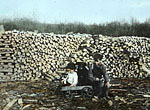|
|
|
Marketing CanadaCanada suffered from chronic labour and capital shortages mainly due to the sheer size of its territory and the cost in men, money and machines needed to develop its industries and take the products to market. As early as 1623, the state had intervened when Louis XIII of France formed the Company of One Hundred Associates to sponsor 4,000 settlers to New France. In the early 1800s, Britain demanded that the Hudson's Bay Company colonize parts of its vast land grant. Upper Canadian officials pursued Scottish Highlanders to settle today's Ontario. In 1891, the Colonization of Manitoba Society managed to repatriate 3,000 Canadians from New England to Red River parishes. At the time, the United States were the real draw in North America, even for Canadians, a million of whom lived there. Canada's surges of immigration came in 1896-1914, the 1920s and the 1950s-1960s. Yet, only during the first period was there intense international marketing to attract newcomers. The story of Clifford Sifton, a young western Canadian politician who was Minister of the Interior in the Laurier government of 1896, is well known. He is the man who filled the Prairies with people. His strategy was fourfold:
Some businesses had their own selling campaigns. The Canadian Pacific Railway even had its own colonizing arm and willingly sponsored three motion picture series extolling the richness, beauty and availability of western farmlands. In the 1920s Cunard, the British passenger shipping company, advertised as a land of opportunity. Other railways, the Canadian Northern and the Grand Trunk Pacific, joined in, circulating posters, brochures, and timetables, especially in England. All these efforts had a tremendous effect; upwards of two million people immigrated to Canada during the "Laurier boom", over half of whom were from the British Isles. Advertising Canada and its provinces to attract overseas and continental tourists has long been an economic activity of governments, transportation companies, recreational complexes, hotel chains and travel companies. In fact, Canadians owe the establishment of their first national park, Banff National Park, in the Rocky Mountains, to Canadian Pacific; the railway needed a reliable tourist trade as part of its revenue to prosper in the first years of operation. But the most successful marketing of Canada came in 1896-1914 with the great drive for immigrants. If you are interested in reading the testimonies of recent immigrants to Canada you can link to the "The journey" section of the Passages to Canada site. |
Bibliography · Links · Credits · Index


